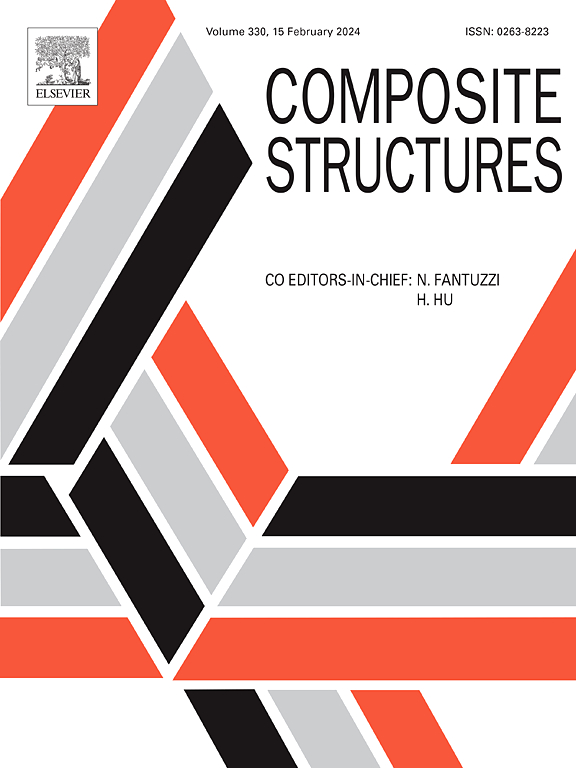Machine learning-based prediction of bond performance of FRP composite bars in concrete for marine composite structures
IF 6.3
2区 材料科学
Q1 MATERIALS SCIENCE, COMPOSITES
引用次数: 0
Abstract
The bond between Fibre Reinforced Polymer (FRP) bars and concrete degrades under seawater, compromising the structural integrity of FRP-reinforced concrete structures in marine environments. Accurate modelling of this bond behaviour is important for ensuring the reliability of such structures. The objective of this study is to develop and evaluate advanced tree-based machine learning (ML) models, including Extreme Gradient Boosting (XGBoost), M5P, and Random Forest, to accurately predict the bond strength retention and failure modes of FRP-reinforced concrete exposed to seawater. A database of 658 experimental results was collected, considering 14 influential parameters, and used to train and test the models. Despite the inherent variability in durability results, the developed models achieved satisfactory predictive accuracy. Feature contribution analysis identified concrete compressive strength as the most significant factor, followed by conditioning duration and bar surface condition. Lesser contributions came from concrete type, conditioning temperature, bar tensile strength, concrete cover, bar elastic modulus, bar diameter, and fibre type, with minimal impact from sustained load, resin type, bond length, and test type. Compared to Fib Bulletin 40 predictions, the ML models showed good accuracy within the range of available conditioning durations. However, accuracy diminished for marginal durations like 365 days due to limited data, indicating lower extrapolation capability and the need for longer-duration experimental results to enhance predictive performance.
基于机器学习的海洋复合结构混凝土FRP筋粘结性能预测
海水作用下,纤维增强聚合物(FRP)钢筋与混凝土之间的粘结会降解,影响海洋环境中FRP增强混凝土结构的完整性。这种键行为的精确建模对于确保这种结构的可靠性非常重要。本研究的目的是开发和评估先进的基于树的机器学习(ML)模型,包括极端梯度增强(XGBoost)、M5P和随机森林,以准确预测frp钢筋混凝土暴露在海水中的粘结强度、保留和破坏模式。考虑了14个影响参数,收集了658个实验结果的数据库,并用于模型的训练和测试。尽管耐久性结果存在固有的可变性,但所开发的模型取得了令人满意的预测精度。特征贡献分析表明,混凝土抗压强度是最重要的影响因素,其次是调理时间和钢筋表面状况。混凝土类型、调节温度、钢筋拉伸强度、混凝土覆盖层、钢筋弹性模量、钢筋直径和纤维类型的影响较小,持续载荷、树脂类型、粘结长度和测试类型的影响最小。与Fib Bulletin 40预测相比,ML模型在可用的条件作用持续时间范围内显示出良好的准确性。然而,由于数据有限,在365天这样的边际持续时间内,准确性会下降,这表明外推能力较低,需要更长的实验结果来提高预测性能。
本文章由计算机程序翻译,如有差异,请以英文原文为准。
求助全文
约1分钟内获得全文
求助全文
来源期刊

Composite Structures
工程技术-材料科学:复合
CiteScore
12.00
自引率
12.70%
发文量
1246
审稿时长
78 days
期刊介绍:
The past few decades have seen outstanding advances in the use of composite materials in structural applications. There can be little doubt that, within engineering circles, composites have revolutionised traditional design concepts and made possible an unparalleled range of new and exciting possibilities as viable materials for construction. Composite Structures, an International Journal, disseminates knowledge between users, manufacturers, designers and researchers involved in structures or structural components manufactured using composite materials.
The journal publishes papers which contribute to knowledge in the use of composite materials in engineering structures. Papers deal with design, research and development studies, experimental investigations, theoretical analysis and fabrication techniques relevant to the application of composites in load-bearing components for assemblies, ranging from individual components such as plates and shells to complete composite structures.
 求助内容:
求助内容: 应助结果提醒方式:
应助结果提醒方式:


